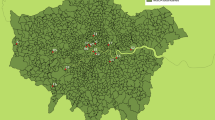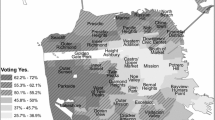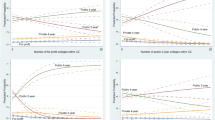Abstract
Having the ability to predict enrollment is an important task for any school’s recruiting team. The purpose of this study was to identify significant factors that can be used to predict the spatial distribution of enrollments. As a case study, we used East Tennessee State University (ETSU) pharmacy school, a regional pharmacy school located in the Appalachian Mountains. Through the application of a negative binomial regression model, we found that the most important indicators of enrollment volume for the ETSU pharmacy school were Euclidean distance, probability (based on competing pharmacy schools’ prestige, driving distance between schools and home and tuition costs), and the natural barrier of the Appalachian Mountains. Using these factors, together with other control variables, we successfully predicted the spatial distribution of enrollments for ETSU pharmacy school. Interestingly, gender also surfaced as a variable for predicting the pharmacy school’s enrollment. We found female students are more sensitive to the geographic proximity of home to school.



Similar content being viewed by others
References
Abbott, W. F., & Schmid, C. F. (1975). University prestige and first-time undergraduate migration in the United States. Sociology of Education, 48(2), 168–185.
Appalachian Regional Commission. (2007). Economic overview. Retrieved October 21, 2007 from http://www.arc.gov/index.jsp
Baryla, E., & Dotterweich, D. (2004). Student migration: Do significant factors vary by region? Education Economics, 9(3), 269–280.
Bauer, P., & Riphahn, R. T. (2007). Heterogeneity in the intergenerational transmission of educational attainment: evidence from Switzerland on natives and second-generation immigrants. Journal of Population Economics, 20(1), 121–148.
Checchi, D. (2000). University education in Italy. International Journal of Manpower, 21(3–4), 177–205.
Chisholm, M. A., Cobb, H. H., & Kotzan, J. A. (1995). Significant factors for predicting academic success of first-year pharmacy students. American Journal of Pharmaceutical Education, 59, 364–370.
Cline, R. R., & Mott, D. A. (1999). Relationship between attitudes, demographics and application decisions among pre-pharmacy students: An exploratory investigation. American Journal of Pharmaceutical Education, 63, 394–401.
Fuller, W. C., Manski, C. F., & Wise, D. A. (1982). New evidence on the economic determinants of post-secondary schooling choices. Journal of Human Resources, 17(4), 477–498.
Gershon, S. K., & Cultice, J. M. (2000). How many pharmacists are in our future? Presented at the Annual Meeting, American Society of Health-System Pharmacists, Philadelphia, PA, June 5, 2000. http://www.hhs.gov/pharmacy/phpharm/howmany.html
Goenner, C. F., & Pauls, K. (2006). A predictive model of inquiry to enrollment. Research in Higher Education, 47(8), 935–956.
Greene, W. H. (1997). Econometric analysis (3rd ed.). New York, NY: Prentice Hall.
Guo, G. (1996). Negative multinomial regression models for clustered event counts. Sociological Methodology, 26, 113–132.
Hagstrom, W. O. (1971). Inputs, outputs, and the prestige of university science departments. Sociology of Education, 44(4), 375–397.
Hearn, J. C. (1988). Attendance at higher-cost colleges: Ascribed, socioeconomic, and academic influences on student enrollment patterns. Economics of Education Review, 7(1), 65–76.
Houglum, J. E., Aparasu, R. R., & Delfinis, T. M. (2005). Predictors of academic success and failure in a pharmacy professional program. American Journal of Pharmaceutical Education, 69(3), 283–289.
Huff, D. L. (1963). A probabilistic analysis of shopping center trade areas. Land Economics, 39, 81–90.
Imai, K., King, G., & Lau, O. (2007). Negbin: Negative binomial regression for event count dependent variables. In Zelig: Everyone’s statistical software. Retrieved Oct 15, 2007 from http://gking.harvard.edu/zelig
Jacobs, J. A. (1996). Gender inequality and higher education. Annual Review of Sociology, 22, 153–185.
Jacody, K. A. (1978). The use of demographic and background variables as predictors of success in pharmacy school. American Journal of Pharmaceutical Education, 42(1), 4–7.
Kogut, B., & Chang, S. J. (1991). Technological capabilities and Japanese foreign direct investment in the United States. The Review of Economics and Statistics, 73(3), 401–413.
Kyung, W. (1996). In-migration of college students to the state of New York. Journal of Higher Education, 67(3), 349–358.
Leppel, K. (1993). Logit estimation of a gravity model of the college enrollment decision. Research in Higher Education, 34(3), 387–398.
MacDermott, K. G., Conn, P. A., & Owen, J. W. (1987). The influences of parental education level on college choice. Journal of College Admissions, 115, 3–10.
Macisco, J. J., & Pryor, E. T. (1963). A reappraisal of Ravenstein’s “laws” of migration: A review of selected studies of internal migration in the United States. The American Catholic Sociological Review, 24(3), 211–221.
Maddala, G. S. (1983). Limited-dependent and qualitative variables in econometrics. Cambridge, UK: Cambridge University Press.
Manski, C. F. (2000). Economic analysis of social interactions. Journal of Economic Perspectives, 14(3), 115–136.
Marble, D. F., Mora, V. J., & Herries, J. P. (1995). Applying GIS technology to the freshman admissions process at a large university. Retrieved Oct 15, 2007 from http://gis.esri.com/library/userconf/proc95/to200/p182.html
Miller, H. J., & Finco, M. V. (1995). Spatial search and spatial competition: A probability analysis of basic results from the spatially-restricted theory. The Annals of Regional Science, 29(1), 67–89.
Okabe, A., & Okunuki, K.-I. (2001). A computational method for estimating the demand of retail stores on a street network and its implementation in GIS. Transactions in GIS, 5(3), 209–220.
Osgood, D. W. (2000). Poisson-based regression analysis of aggregate crime rates. Journal of Quantitative Criminology, 16(1), 21–43.
Sa, C. (2006). Does accessibility to higher education matter? Choice behavior of high school graduates in the Netherlands. Spatial Economic Analysis, 1(2), 155–174.
Sa, C., Florax, R., & Rietveld, P. (2004). Determinants of the regional demand for higher education in the Netherlands: A gravity model approach. Regional Studies, 38(4), 375–392.
Sanders, N. F. (1986). The college selection process: Research within the twelfth-grade marketplace. Journal of College Admissions, 111, 24–27.
Sinha, A. (2000). Understanding supermarket competition using choice maps. Marketing Letters, 11(1), 21–35.
Toutkoushian, R. K. (2001). Do parental income and educational attainment affect the initial choices of New Hampshire’s college-bound students? Economics of Education Review, 20(3), 245–262.
White, G. C., & Bennetts, R. E. (1996). Analysis of frequency count data using the negative binomial distribution. Ecology, 77(8), 2549–2557.
Willis, S. C., Shann, P., & Hassell, K. (2006). Who will be tomorrow’s pharmacists and why did they study pharmacy? The Pharmaceutical Journal, 277(7410), 107–108.
Witteman, J. K., Schimpfhauser, F. T., & Crowley, A. (1975). Dentistry, medicine, and pharmacy: Temperament, interests, ability, and socioeconomic index of three stable career groups. Journal of Dental Research, 54, 548–552.
Young, W. J. (1975). Distance decay values and shopping center size. The Professional Geographer, 27(3), 304–309.
Author information
Authors and Affiliations
Corresponding author
Rights and permissions
About this article
Cite this article
Chen, K., Kennedy, J., Kovacs, J.M. et al. A spatial perspective for predicting enrollment in a regional pharmacy school. GeoJournal 70, 133–143 (2007). https://doi.org/10.1007/s10708-008-9120-5
Received:
Accepted:
Published:
Issue Date:
DOI: https://doi.org/10.1007/s10708-008-9120-5




